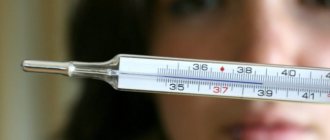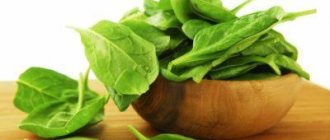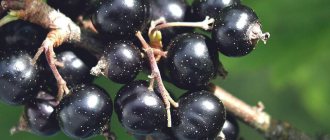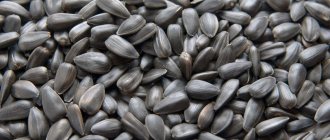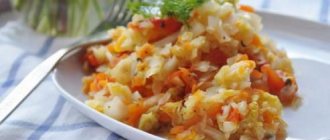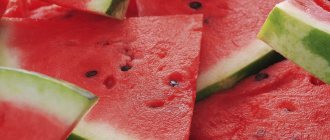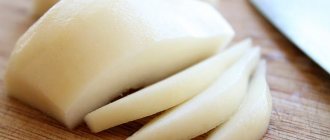Medical Consultant Breastfeeding Disputes about semolina: how to use semolina porridge while breastfeeding and not cause harm
Cabbage soup and porridge are our food. So goes the old Russian proverb. And the period of breastfeeding especially supports this thesis in relation to cereals. At the same time, cereals are different from cereals, and semolina often causes conflicting opinions. Let's consider how useful and appropriate it is to consume semolina porridge during lactation.
- Semolina porridge during breastfeeding - execution cannot be pardoned
Rules for eating semolina porridge during lactation
- Introducing semolina porridge into the diet in the first month of breastfeeding
- Milk semolina porridge - timing of administration during breastfeeding
The benefits and harms of semolina porridge during breastfeeding
In Soviet times, semolina porridge was a frequent guest on the table of almost every family. The child's menu necessarily included this simple dish. In recent years, the situation has changed significantly, and semolina has lost its popularity. However, even now there are many fans of well-prepared semolina porridge. Breastfeeding women are no exception. Taking into account the lack of time and lack of energy for cooking, semolina porridge during breastfeeding could be an excellent option. The speed of preparation and excellent taste make this dish especially attractive. Is it possible to have semolina porridge while breastfeeding? Will this harm the baby? Let's try to figure it out.
Nutritional value
Includes:
The calorie content of ready-made semolina porridge cooked in water is relatively low - only 80 kcal per 100 grams.
The product is rich in “light” carbohydrates and quickly satisfies hunger. But at the same time, the vitamin and mineral composition of semolina is negligibly poor, and a nursing mother needs adequate nutrition. Therefore, semolina during breastfeeding should not become a frequent dish on the menu of a young mother.
How to choose the right semolina in the store
This product is used to prepare cheesecakes, casserole, porridge, manna during breastfeeding. You need to choose cereals according to the following rules:
- GOST is a guarantee of high quality, good cleaning and grinding.
- Cereals are not divided into types and categories, but they are chosen by brand - “M”, “T”, “MT”. A product made from durum wheat has a low glycemic index.
- It is better to choose semolina packaged in plastic bags. This will allow you to see the presence of insects and lumps that appear in the cereal due to improper storage or production.
- All grains must be the same size and color, only in this case you will get a good porridge.
- Sometimes you have to buy semolina from different manufacturers when breastfeeding in order to find quality products.
What is the danger of semolina
Semolina contains gluten in large quantities. Many people suffer from intolerance to this component - celiac disease. A newborn baby may also exhibit this feature. In this case, it is undesirable to consume this dish during breastfeeding. Or you need to carefully monitor the baby's reaction after breastfeeding.
What manifestations indicate gluten intolerance in a baby:
- frequent loose stools;
- increased gas formation;
- irritability;
- rashes.
If any negative consequences occur after eating semolina porridge, it is necessary to exclude the dish from the diet. If in doubt, it may be a good idea to have your baby’s blood tested. Gluten intolerance can be congenital or temporary. As your baby gets older, his gut will become stronger and he will no longer react negatively to gluten.
If the child’s behavior does not change in any way after feeding, then there is no negative reaction to gluten. And a nursing mother can easily afford a plate of aromatic delicacy.
However, you shouldn’t get carried away and cook this dish too often. The poor composition makes semolina a far from ideal choice.
There is a widespread myth that semolina interferes with the absorption of calcium by the mother's body. In fact, the danger is greatly exaggerated. Phytin, a substance that supposedly reduces the absorption of calcium in the intestines, is found in the shell of wheat grain. When processing the grains, it is removed, and already cleaned grains are used for the production of semolina. Therefore, there is no phytin in semolina.
In addition, on the contrary, phytin is used to normalize phosphorus-calcium metabolism and is sometimes added to medications.
Introduction rules
How to correctly introduce semolina porridge into the menu of a nursing mother:
- Semolina dishes during breastfeeding should not be present in the mother’s diet until the child is 3-4 months old. And only then can you carefully try to introduce semolina into your mother’s diet.
- It is advisable to cook porridge in water or dilute milk with water. Don't cook the porridge too thick.
- When trying a new dish for the first time while breastfeeding, you need to carefully monitor the baby’s reaction. If there are no changes, then semolina is allowed.
- Due to the low nutritional value of the product, you should not include porridge in your diet more than twice a week.
Despite the fact that for many, semolina porridge is a childhood nightmare, there are still big fans of this simple dish. When prepared correctly, you can get a very tasty result. A young mother often lacks the twenty-fifth hour in the day, and a simple and quick recipe for a hearty dish will more than once help out during the difficult days of the baby’s first year of life. Although semolina porridge will not bring much benefit, there is no harm from it either. From time to time it is quite possible to indulge in such a delicacy.
Can a nursing mother have semolina porridge?
Every new mother faces the urgent question of making her own nutrition balanced and sufficiently rich in essential vitamins and microelements. After all, every nursing mother wants as many useful substances as possible to enter the baby’s body with milk. In this regard, cereals such as semolina are a rather controversial product. To understand whether semolina porridge is allowed during breastfeeding, let's look at its composition and note all its pros and cons.
Production and composition of semolina
Semolina is obtained by processing wheat grains. In fact, semolina is the same wheat flour, only more coarsely ground, made from both soft and hard varieties of wheat.
During the cooking process, semolina swells due to the high content of starch, gliadin and glutenin proteins in its composition. It is because of starch that semolina has a high energy value. But the content of fat and fiber in semolina kernels is negligible. The same can be said about most microelements and vitamins that leave semolina at the grinding stage.
What is semolina made from?
Semolina is obtained at flour mills during the processing of wheat. If the package with semolina is marked “M”, then this indicates that soft varieties of wheat were used, respectively, “T” - hard, “MT” - a mixture of hard and soft. “Soft” semolina is white, and “hard” semolina has a yellowish tint.
We can say that semolina is wheat flour, but more coarsely ground with small particles of grain kernels with a diameter of 0.25 mm to 0.75 mm. Semolina made from soft wheat boils quickly and swells more, and it is this semolina that is most often used for preparing porridges. From durum semolina you can cook porridge similar to cereal - crumbly, with less volume but a richer taste.
The porridge swells due to the high content of gliadin, glutenin and starch proteins in the endosperm (kernel) of wheat, which absorb 200–300% of water relative to their weight. The chemical composition of the endosperm from which semolina is obtained is presented:
- starch (78–82%),
- protein (13–15%),
- sucrose (2%).
The same applies to vitamins, since the main part of them, along with micro and macroelements, leaves semolina with a grinding by-product - bran. The main vitamins of semolina are B1, B2, B6, H, PP.
The special status of oatmeal during breastfeeding
The benefits and harms of semolina porridge
The beneficial properties of semolina porridge include:
- Despite the fact that semolina cannot boast of an impressive list of vitamins and microelements included in its composition, the presence of vitamins B, E, and PP in it is pointless to deny. These are no less important vitamins involved in maintaining healthy functioning.
- Porridge made from semolina is a fairly high-calorie dish that can saturate a woman’s body with easily digestible carbohydrates, thereby replenishing the energy costs necessary to maintain lactation.
Mothers suffering from kidney disease should not be afraid of semolina porridge. Semolina does not contain harmful proteins that can negatively affect kidney health, which means it can be eaten by women with kidney diseases.
To answer your question, can a nursing mother have semolina porridge, you need to carefully consider the listed disadvantages of this cereal:
- Semolina contains gluten protein. Therefore, if a mother or newborn suffers from intolerance to this protein, then it is worth excluding from your diet any products made from wheat, including semolina. You can tell that a child has gluten intolerance by the appearance of intestinal colic and an allergic reaction on the skin. But it will be possible to confirm your suspicions only after examining a doctor and donating blood for tests.
- The presence of a substance such as phytin in semolina can also be considered a disadvantage. Phytin does not allow calcium, iron and vitamin D to be fully absorbed. Therefore, during breastfeeding it is worth limiting the consumption of products containing it. But you should pay special attention to what type of semolina you decide to cook the porridge from. If these are soft varieties of wheat, then you should not worry about a large amount of phytin in your dish, since it is eliminated during the grinding of the cereal and is an integral part of the bran.
- The high calorie content of semolina porridge can be attributed to both the pros and cons of the product. Therefore, if you want to restore your thin waist after childbirth, semolina porridge should be excluded from your diet while breastfeeding.
- Regular consumption of semolina can negatively affect the functioning of the digestive system, since semolina contains the substance gliadin, which can help destroy villi in the intestines, disrupting the process of digestion and absorption of food.
In short, the presence of microelements and vitamins in semolina porridge is canceled out by the presence of phytin. And the restoration of energy costs is due only to easily digestible carbohydrates, which quickly satisfy the feeling of hunger, but at the same time just as quickly add extra pounds and centimeters.
“Bad” and “good” semolina porridge: all the pros and cons
1. Nutritional value of semolina
From the point of view of a healthy diet, semolina porridge has no value. Substances that are most beneficial for digestion and human health are concentrated in the peripheral parts of the wheat grain, which are removed during the production of cereals. It contains very few vitamins and minerals.
But the same can be said about white bread, since their composition is identical, except for the yeast. Despite this, “bread is the head of everything,” and rarely does it occur to anyone to talk about its dangers.
Semolina porridge helps well with exhaustion and quickly saturates the body with “light” carbohydrates. The protein component of porridge, although not comparable to meat, eggs or fish, will satisfy part of the body's needs for 11 essential amino acids. If a nursing mother is very hungry, and there is a mouse hanging in the refrigerator, then semolina porridge can quickly satisfy the feeling of hunger and replenish the body with the necessary energy to support breastfeeding.
The calorie content of porridge (without sugar, butter, milk and other additives), contrary to popular belief, is not so high - 80 kcal per 100 grams. But by eating only one semolina, you can quickly stretch out your legs due to the imbalance of its composition and the lack of all the necessary components for proper breastfeeding and the health of the nursing mother.
2. Gluten: is it dangerous for a child?
Gluten is the main protein of semolina and a strong argument in favor of a nursing mother not consuming semolina porridge. Often, newborns and young children experience intolerance to this plant protein. It can be congenital, when a nursing mother or relatives of the baby have such a disorder, or temporary.
Congenital intolerance occurs when there is a hereditary deficiency of enzymes capable of digesting protein and is lifelong. This anomaly is called celiac disease.
Undigested gluten molecules damage the intestinal villi and reduce the number of beneficial microflora.
As a result, the digestion process worsens, and the body is poisoned by waste products of pathogenic microorganisms that beneficial bacteria cannot cope with.
Which nuts are best for breastfeeding and what are their dangers?
Temporary intolerance goes away as the child grows and the digestive system matures. Now pediatricians, in order not to provoke an allergy in a child, recommend starting complementary feeding with gluten-free porridges - buckwheat, corn or rice. When breastfeeding, gluten molecules that are not broken down by the mother's digestive system can be absorbed into the blood and then penetrate into breast milk. How can you tell if your breastfed baby is gluten intolerant?
Please note that after eating baked goods and semolina porridge, a child experiences diarrhea, increased gas production, skin rashes on the knees, buttocks, elbows and head, pale skin, and irritability.
To confirm your suspicions, you can donate blood from a vein to check for antibodies to cereal proteins. If a baby has a temporary gluten intolerance, then you should give up semolina porridge and try to introduce it into your diet gradually, no earlier than the child reaches 3-4 months of age.
3. Phytin and decreased calcium absorption
There are legends that semolina porridge reduces the absorption of calcium. Moreover, an innocent substance in wheat cereal - phytin - has undeservedly suffered from people's rumors. Firstly, phytin is concentrated in the wheat shell, which is eliminated when the grain is crushed and becomes a component of bran. Secondly, phytin is known in medicine as a substance that normalizes phosphorus-calcium metabolism and promotes bone formation. It is even added to the vitamin-mineral complex D-calcine to enhance the effect. In the intestines, it binds excess calcium if you have eaten too much phytin, as they say.
Another thing is starch, of which there is a lot in semolina porridge. It can impair the absorption of calcium. And it is also reduced:
- zinc and iron,
- competing with calcium for absorption,
- cellulose,
- sweets,
- coffee,
- fatty food,
- oxalic acid, found in beets, spinach, almonds and rhubarb,
- animal proteins,
- sedentary lifestyle,
- stress and age,
- urolithiasis disease,
- bleeding disorders,
- reduced immunity and so on.
What baking recipes are suitable for nursing mothers and is it possible to eat pies on the sly from a pediatrician
So the statement that semolina porridge is not allowed due to impaired absorption of calcium is far-fetched. When breastfeeding, nothing prevents you from separating the intake of calcium antagonist products with foods rich in this mineral.
If you look at it from this angle, then milk semolina porridge is a useless food for the purpose of obtaining calcium from milk.
So is it possible or not to have semolina porridge while breastfeeding? It is harmful only in one case - if your baby has gluten intolerance. In all other respects, semolina is an absolutely harmless product. Just do not forget that everything should be in moderation and with the help of only this dish you will not be able to provide adequate nutrition during breastfeeding.
Semolina is a dairy dish that is distinguished not only by its delicate texture and pleasant taste, but also by its beneficial properties. It is saturated with minerals - titanium, calcium and zinc, iron. As for vitamins, semolina contains the following: E, PP, B6. A distinctive feature of semolina is its nutritional value, benefits for children and adults. However, despite its unique composition and beneficial properties, nutritionists and doctors do not recommend eating it during lactation. This is explained by the fact that it contains some microelements that will be harmful to infants. These include starch, gluten, and phytin. If you decide to cook it while breastfeeding, you should follow some rules.
Semolina during breastfeeding could become a chic dish, a true salvation for young mothers. The dish has many advantages: tasty, nutritious, healthy, satisfying, and also prepares very quickly. Semolina could significantly embellish a simple, meager diet, especially in the first months after childbirth. This milk porridge can replenish large energy reserves for a long time. Despite all the positive aspects, pediatricians unanimously say that semolina porridge is undesirable during breastfeeding. What is the reason for the ban?
In order to answer this question, it is necessary to understand the composition and properties of the product. It is important to remember that dairy products are an essential part of a young mother’s diet, as they contain a lot of calcium, which plays a significant role during growth and development. It is possible to introduce semolina into the diet of a nursing woman, but very carefully and gradually.
Pediatricians prohibit eating semolina porridge too often during breastfeeding, but it can be introduced into the diet in moderate and limited quantities. It is advisable to cook it in water or diluted milk.
Despite the fact that semolina is considered a dietary product, you should treat it with extreme caution, given its properties:
- Cereals contain quite a lot of gluten, which can cause allergies.
- There is a high percentage of phytin content. This component prevents the full absorption of calcium, iron and vitamin D. That is why semolina porridge eaten by a nursing woman can disrupt the activity of the gastrointestinal tract.
- The porridge is quite high in calories, so it can cause increased gas formation, intestinal colic and bloating in the baby.
- Contributes to the development of pathologies such as rickets if there is a deficiency of vitamin D.
- for the first time, semolina porridge must be boiled in water;
- the consistency of the finished dish should be liquid;
- the optimal serving size is 100 grams;
- In order for semolina to be absorbed well and quickly, it should be eaten on an empty stomach;
- the daily norm of semolina porridge is no more than 200 grams, the weekly norm is 400 grams;
- The serving size can be slightly increased if the baby does not have a negative reaction - itching, colic, skin rash.
So that a young mother can safely eat semolina, it is important to prepare it correctly. Do not cook in large quantities. The best option is to cook the porridge for one or two servings so that it is fresh and hot.
Rules for eating semolina porridge for a nursing mother
After weighing all the pros and cons, you can come to a general decision that semolina porridge does not provide any particular benefit. But, despite these disadvantages, you should not completely abandon this hearty and tasty porridge. To ensure that the presence of semolina in the diet does not harm either the baby or the nursing mother and that all the disadvantages of this cereal can be easily minimized, you need to follow simple recommendations for eating and preparing porridge:
- It is necessary to completely stop eating semolina in the first couple of months of the baby’s life, when his digestive system is still too sensitive and is just beginning to adapt to the new diet.
- If after 2-3 months the baby suffers from colic, then you should postpone eating semolina until he is 4-5 months old.
- Like any other product, mommy needs to introduce semolina porridge into her diet in the form of a small portion, and then observe the baby’s reaction throughout the day. If there are any signs of allergy, you should avoid this type of cereal.
- You need to cook semolina porridge in water and do not add too much sugar. If the child’s reaction is good, you can dilute the water in which the semolina porridge is cooked in half with milk.
- Try to give the semolina porridge the most liquid consistency. So there will be very little semolina in the finished dish, which means it won’t do much harm.
- Eat semolina porridge for breakfast no more than 1-2 times a week. This diet during breastfeeding will not harm either the baby or the nursing mother, because porridge is absorbed better on an empty stomach, which is why the unpleasant consequences of its consumption will be minimized.
Recipe for making healthy semolina porridge
To make a tasty and healthy dairy dish, you need to follow the cooking rules:
- 2 cups of milk are poured into the pan and brought to a boil.
- Pour 2 tbsp into the hot liquid in a thin stream. l. semolina, remembering to stir constantly to avoid the appearance of lumps.
- While the porridge is cooking, it needs to be constantly stirred.
- After 5-9 minutes, add sugar and salt to taste to the dish, and remove the pan from the heat.
- The semolina should sit for 10 minutes.
To diversify the taste of the dish, you can use kefir, a slice, fruit or jam as an additive. Both a saucepan and a multicooker are used for cooking.
Lactation is not a death sentence, but simply some changes in a woman’s diet. After childbirth, the list of allowed foods is sharply reduced and you have to think about your diet. Semolina is useful during breastfeeding, but it should be consumed in moderation. Your pediatrician will provide all additional information about permitted products.
Semolina porridge in the diet of a nursing mother is welcomed and recommended by leading nutritionists and pediatricians. It will not only diversify the breastfeeding menu, but will also help you feel full and replenish lost strength.
REFERENCE!
According to the famous pediatrician Komarovsky, semolina porridge can be eaten by both a nursing mother and introduced into complementary foods for the baby. In his works, he notes the enormous benefits of this product.
From what month can it be included in the diet?
It is recommended to eat semolina porridge after two months after giving birth. Try it for the first time in small quantities (cook the porridge itself not with milk, but with water without adding butter or jam). You should definitely observe the baby’s reaction; if no negative manifestations are noticed, then the portion can be increased, then cooked with milk.
How can it be useful for a mother?
Semolina is a truly rich product
. It is made from the very core of wheat grain, while all the necessary microelements and substances are preserved. Semolina in combination with milk contains a large amount of the following elements:
Composition of semolina porridge - benefits and harm to the body
Semolina is very finely ground wheat. It is believed that this is the least useful type of grain processing, since a significant part of the beneficial substances is lost during grinding.
The composition of semolina is quite diverse and ambiguous. There are many useful substances in semolina:
- Vitamin E in cereals helps the functioning of brain neurons and liver cells and is involved in collagen synthesis.
- It is not for nothing that the B vitamins included in cereals are called “beauty vitamins”: they have a positive effect on the condition of the skin, hair and nails. In addition, hemoglobin is formed under the influence of vitamins of this group.
- Potassium in cereals is necessary for normal heart function and also protects against chronic fatigue syndrome.
- Phosphorus is indispensable for the formation and maintenance of good condition of bones and teeth.
- Iron prevents thyroid problems, anemia and decreased immunity.
- Sodium, which is part of semolina, regulates the water-salt balance in our body and is actively involved in the functioning of the kidneys.
At the same time, semolina also contains controversial substances:
- A large amount of starch in cereals is the reason for the high glycemic index: such porridge is quickly digested and contributes to an increase in blood glucose.
- Gluten, or gluten, leads to thinning of the intestinal mucosa, which causes poor absorption of nutrients from food. In addition, gluten is a common cause of allergies in children.
- Phytin, also included in semolina, significantly interferes with the absorption of calcium, leading to osteoporosis and causing rickets.
Benefit
Semolina is obtained by processing wheat grains; this product has a very rich vitamin composition, including all B vitamins, as well as E and PP. In addition, the product contains a significant amount of trace elements Ca, Fe, Zn, Cu, F, Mo, Ni, Se and many others. Semolina porridge has an increased nutritional and energy value, while it contains practically no fiber, but starch makes up 2/3 of the total composition.
Largely due to this, the porridge turns out to be extremely satisfying, and it’s easy and quick to prepare – and this is exactly what a new mother needs, who sometimes doesn’t have time to devote even ten minutes of free time to herself.
After having breakfast with semolina porridge, you can calmly forget about the unpleasant feeling of hunger for several hours and take care of yourself and your child without distraction. The benefits of semolina porridge have been repeatedly proven - once it enters the stomach and intestines, it envelops their walls and protects them for several hours.
That is why porridge is often recommended for women with ulcers, gastritis and irritable stomach syndrome.
It is well known that many chronic diseases worsen during pregnancy, but the use of medications is not recommended for breastfeeding mothers, so eating semolina porridge gently protects the digestive organs of the young mother, relieves pain and spasms.
Including this porridge in the menu significantly improves the condition of hair, nails and teeth. Everyone knows that during pregnancy and lactation, women very often experience problems with these organs - teeth crumble, hair falls out, and nails break. Semolina porridge is considered a real energy pantry; it allows you to quickly restore strength after an exhausting pregnancy and childbirth, in addition, it relieves the feeling of chronic fatigue, which is familiar to many women after sleepless nights while caring for a newborn.
Many people think that semolina is too high in calories. This is a common misconception - 100 g of porridge contains only 98 kilocalories
, so girls after childbirth and even those who cannot return to their previous shape can eat the dish without fear of gaining extra pounds.
Semolina porridge during breastfeeding - execution cannot be pardoned
From Soviet times to modern maternity hospitals, the rule has come to give semolina to mothers who have just given birth. But in order to eat porridge without fear, you need to know the features of its administration and use.
Rules for eating semolina porridge during lactation
In order for semolina porridge to be beneficial and not harm mother and baby, you must follow the following rules.
- Consume semolina in small quantities - no more than 1 serving per day a couple of times a week, since the high calorie content of this dish will quickly lead to excess weight gain.
- Carefully monitor your baby's reaction or do a test for intolerance to gluten, which is contained in large quantities in this product.
- Use semolina porridge no more than 2-3 times a week, so as not to provoke intestinal disorders.
- Combine eating porridge with foods containing calcium - for example, cottage cheese. However, it is not recommended to combine these products into one meal due to their incompatibility. It is optimal to consume cottage cheese 30–60 minutes after semolina porridge.
Introducing semolina porridge into the diet in the first month of breastfeeding
Despite numerous discussions in modern medicine regarding the benefits and harms of semolina during breastfeeding, in maternity hospitals this cereal is an integral part of the diet of mothers.
The calorie content of semolina porridge cooked with water is 80 kcal per 100 g, and porridge cooked with milk is 98 kcal per 100 g of product.
To ensure that the mother’s diet, which is already very limited in the first month of lactation, is rich in nutrients, semolina porridge can be included in the menu . But at the same time follow these recommendations:
- The porridge should not be too thick; it is optimal to consume it in a liquid form;
- At first, it is better to cook with cereal and water, without using fresh milk, which is a strong allergen.
When a nursing mother introduces semolina into her diet, even if this happens in the maternity hospital, it is advisable to limit yourself to consuming 100 g of the product rather than eating the entire portion. It is recommended to eat this porridge on an empty stomach, so it is better absorbed.
After the first test, you need to monitor the baby’s reaction for 1–2 days. You should be wary of:
- skin rash;
- tense tummy;
- increased gas formation.
Allergy symptoms in a baby: rash on the face and body, bloating, colic
If these phenomena are present, then it is worth holding off on consuming this cereal until the child’s gastrointestinal tract becomes more mature - 2-3 months after birth. If the baby does not have a negative reaction, the mother can easily afford to use this product, not forgetting the norm: the daily diet is no more than 150–200 g, the weekly diet is within 350–400 g .
Milk semolina porridge - timing of administration during breastfeeding
If a nursing mother successfully eats semolina porridge in water and the baby does not have a negative reaction, you can gradually introduce semolina cooked in milk. After all, milk not only significantly improves the taste of porridge, but also increases its nutritional value.
The optimal timing for introducing milk semolina is no earlier than 2–3 months after the birth of the baby . During this period, the enzyme system of the baby’s gastrointestinal tract is sufficiently formed to adequately respond to dairy products.
The first test follows the usual rules for introducing a new product: eat a small portion of 20–30 g in the morning and observe the baby’s reaction throughout the day. To ensure that the introduction of milk semolina goes without problems, it is recommended to first prepare the porridge with milk diluted with water - in a 1:1 ratio .
In what quantities and how should you eat semolina during lactation?
- It is recommended to start introducing semolina into your diet after 2 months from the birth of the baby.
- There are two options for preparing semolina porridge - with the addition of milk and with the addition of water. If you start eating semolina after a long period of time, it is recommended to do this on the water. You need to prepare a rare porridge and then observe the baby’s reaction. If everything is fine and there are no allergic reactions, you can increase the portion and replace the water with milk.
- During lactation, it is recommended to eat semolina porridge once a week, and the serving per week should not exceed 350 grams.
- It is not recommended to add all kinds of sweeteners to porridge, as well as jam, fruits and berries. This significantly increases the calorie content of the dish, and there is also another unpleasant factor - it can easily cause fermentation in the stomach.
To somehow improve the taste of semolina porridge without adding sweeteners to it, you can use some secrets. For example, you can put a small piece of chocolate or a small piece of candy into semolina porridge. This will add sweetness to the dish, but such an amount will not do any harm at all. In any case, if you do not want unforeseen consequences from eating semolina, you should first consult a specialist for advice.
According to the famous doctor Komarovsky, semolina porridge is very useful for both children and adults. This is a relatively cheap product that contains many useful substances, like many other, more expensive products. And people with low incomes can afford semolina porridge.
Semolina porridge also has healing properties for kidney diseases, because this product does not contain protein, which negatively affects the body in case of such ailments. Eating semolina porridge in moderation is very beneficial for a nursing woman who suffers from kidney disease.
Let's debunk the myth!
There is an opinion that semolina porridge is useless for the body and does not have any positive effects. This is wrong. This opinion was formed due to the lower content of nutrients in this product compared to other cereals.
The diet during feeding should be made in such a way that it contains all useful vitamins and microelements, so you should not neglect food, and you should not eat everything your heart desires. Remember that not only you, but the life and health of your baby depend on your nutrition.
Secrets of making semolina
One of the secrets of semolina porridge without lumps is stirring with a whisk
Here is a recipe for making liquid semolina porridge.
- milk or water - 200 ml;
- semolina - 1 tbsp. l. with a slide;
- salt - a pinch;
- sugar – 1 tsp;
- butter - to taste.
- Rinse the pan with ice water, add milk and bring to a boil.
- Add salt and sweeten the milk.
- Add semolina in a thin stream, stirring continuously.
- Cook for about 3-5 minutes until the cereal is completely swollen, stirring constantly.
- Add butter to the prepared porridge and mix well until it becomes more fluffy.
- Let it brew for 10–15 minutes. The porridge will thicken further.
To make the porridge light, airy and without lumps, the following secrets will help:
- It is better to stir the porridge not with a spoon, but with a whisk, so the cereal will dissolve well and will not form lumps;
- the semolina should be poured in a very thin stream into the funnel formed by the whisk;
- Cool the finished porridge under the lid, so it will not become covered with a film.
Cooking secrets
The body, weakened after childbirth, requires increased attention. Semolina porridge, rich in carbohydrates, will help replenish the missing energy. In order for the dish to turn out without lumps, there is one secret - when cooking, stir the mixture with a whisk. The classic recipe looks like this:
- Take a saucepan or saucepan and rinse with cold water. Pour in 200 ml of water or milk. We wait for the liquid to boil.
- After boiling, reduce the heat to low and add salt and sugar as desired.
- Slowly add 1 tbsp. spoon of semolina, stirring constantly in a circular motion.
- Without stopping stirring, cook for 5 minutes until the grains increase in volume and swell.
- Remove from heat and throw a piece of butter into the porridge - 10 grams, if your mother is allowed animal fats. Mix vigorously until the mixture becomes airy.
- Leave for 10 minutes in a calm state. The porridge will be rich and thicken a little.
If the newborn has a positive reaction to semolina porridge, over time, the nursing mother can supplement the dish with other ingredients. The second secret of delicious porridge is that you need to pour the cereal into the funnel formed by the whisk in a thin stream. The third secret is that when cooling, a film does not form if the prepared plate of semolina is covered with a lid.
The thickness of the porridge depends on the amount of cereal added to the water or milk. In the first days of administration, doctors advise choosing milk with a fat content of no higher than 2.5%, boiling it in water or mixing these two ingredients. Any sweet additions - sugar, candied honey, chocolate, condensed milk - are added immediately after introducing the cereal into the liquid.
Effect on lactation and advice from Dr. Komarovsky
Semolina does not directly affect the production of breast milk, but due to its high calorie content it makes it more nutritious. Thus, the baby gets full faster and easier, while using less milk. At the same time, it is necessary to remember that there are negligible amounts of vitamins and microelements in semolina porridge, therefore, despite all its calorie content, it is not recommended to make it the basis of nutrition, even if the baby does not have a negative reaction . If semolina predominates in the diet of a nursing mother, the baby risks not receiving enough vitamins and minerals, so necessary for its growth and development.
Popular pediatrician Evgeny Olegovich Komarovsky notes the advantage of semolina porridge in its low cost and satiety:
The main benefit is that you can save a lot of money, for example, on cosmetics for your mother. Very filling - in the sense that it leaves the stomach slowly and therefore the feeling of hunger does not come soon.
E.O. Komarovsky
At the same time, the doctor warns that satiety does not mean saturation with all necessary substances:
If there is no money other than for diluted cow’s milk and semolina porridge, then nutrition-related problems are likely to arise.
E.O. Komarovsky
Thus, semolina porridge may well be included in the diet of a nursing mother. The main thing is to observe moderation, and then the “porridge from childhood” will pleasantly diversify the menu.
Contraindications to the use of semolina
Semolina is produced by grinding wheat. But, unlike flour, it has a coarser grind. The diameter of the grain particles varies from 0.25 to 0.75 mm. It is classified depending on the type of wheat and is marked with the letter “M” for soft varieties or “T” for hard varieties. A mixture of these two varieties is designated “MT”. The color of cereals from soft varieties of wheat is usually white, while cereals from hard varieties have a brownish tint.
Semolina porridge has been used in baby food for several generations of compatriots, due to the delicate consistency of the product and ease of preparation. But this product is not as useful as is commonly believed. And that's why:
About semolina porridge
- Semolina is quite poor in vitamins and microelements, so the amount of them that is present in semolina can be obtained by eating an ordinary bun.
- The product in large quantities contains substances harmful to the child, such as gliadin and gluten, which can lead to a decrease in the number of intestinal villi and disruption of its functioning. 15% of the adult population remains gluten intolerant. Fortunately, such a severe hereditary disease as celiac disease, in which you cannot eat gluten-containing foods at all throughout your life, occurs infrequently - only in 0.03% of people.
- Semolina porridge is a fairly high-calorie dish. 100 g of cereal contains on average 12.6 g of protein, 1.5 g of fat and 68.9 g of carbohydrates. The energy value of the product is about 90 kcal per 100 g of the finished dish, and when it is cooked in milk with the addition of butter and sugar, this triples the calorie content.
Therefore, it is quite easy for a nursing mother to gain extra pounds if she eats the dish often enough, especially with low physical activity. And this is in most cases undesirable, because during pregnancy a woman’s body already creates reserves - a kind of reserve for the period of breastfeeding. The product is also not recommended for overweight children.
- There is also phytin in cereals; this substance prevents the absorption of calcium salts from the intestines into the blood, as a result of which a deficiency of this microelement may occur in the body of a small child or a nursing woman.
The question arises: from how many months should semolina be introduced into a child’s diet? According to pediatricians, all these factors can have a negative impact on children under 12 months of age. Doctors unanimously do not recommend introducing any complementary foods at all until 6 months. But after a year, the product can be gradually included in the children’s diet, when the enzymatic system has matured enough and the intestines have already established normal functioning. Up to three years of age, semolina porridge is recommended to be given to children in limited quantities.
Where does semolina grow?
The benefits of semolina
Despite the above-mentioned disadvantages, semolina also has useful properties:
There are two types of semolina
- It is very useful for chronic kidney diseases. Therefore, semolina porridge is recommended for consumption in small quantities by a nursing mother with kidney pathology.
- Semolina is the only cereal product that is absorbed from the lower intestine, so it is prescribed after gastric resection and duodenal surgery, as well as for chronic and acute gastrointestinal diseases. It is able to remove excess mucus and fat from the body and prevent the development of rectal cancer.
- Dishes made from this cereal prevent the loss of minerals from blood cells and support the ligamentous apparatus.
Semolina can also be useful for children, but it depends on the age at which it is given: children after 3 years of age have a mature gastrointestinal tract, are very mobile and need long-term energy replenishment, which this cereal can provide.
Semolina porridge benefits and harms
Manna during breastfeeding: benefit or harm
Mannik is a fairly fatty, high-calorie and difficult-to-digest dessert. It contains large amounts of sugar. This leads to bloating and colic in infants, disruption of stool and digestion. Semolina contains gluten, which causes food allergies. And the high content of chitin in this product complicates the body’s absorption of vitamin D, calcium and iron.
At the same time, semolina performs a number of important properties and functions. The product contains protein, vitamin E and group B, important minerals. Therefore, it saturates the body with useful elements. Semolina cleanses the intestines, removes mucus and removes excess fat. It is useful for diseases of the digestive system, especially ulcers and gastritis. How to cook semolina porridge for a nursing mother, see here.
Semolina restores strength and gives energy, improves mood and relieves stress. It is especially useful for nervous disorders and after operations. And so that manna does not harm the baby, a nursing mother must follow the rules and recommendations for introducing this dessert into the diet.
Cooking
In terms of ease of preparation, semolina is an ideal option. It can be made to any consistency:
- if you take 100 ml of milk 1.5 tbsp. spoons of cereal, you get thick semolina;
- if 1 tablespoon or less, the dish will be liquid.
Overcooked semolina loses up to 70% of all nutrients, so it must be prepared correctly:
- Pour milk into a saucepan and bring to a boil.
- Add the cereal in a thin stream, stirring constantly to prevent lumps from forming.
- Add salt and sugar.
- When the dish is ready, cover the pan with a lid and place a towel on top.
Is it beneficial for a mother to eat the product while breastfeeding, and from how many months can babies be fed semolina porridge?
If a nursing mother likes this product, then it is still possible to eat it once a week. Semolina is undesirable for a young child; doctors allow it to be given to babies from 12 months, but only in special cases when you need to quickly feed the baby.
At the same time, it needs to be made with a liquid consistency, and it is better to feed the child with special mixtures. Until one year of age, a mother should not feed her baby semolina porridge, since its nutritional value is low and ranks last among other cereals. And when the baby celebrates his first birthday, you can start introducing semolina into the diet, if the child does not have allergies, but not more than once a week.
How to cook semolina porridge correctly?
To prepare semolina porridge with milk, you will need to mix one glass of milk and water, pour it into a container, turn on the gas and boil. While stirring the liquid, carefully add two tablespoons of semolina in small portions. If you like thicker porridge, you can add three or four tablespoons of cereal. All this time, the porridge must be stirred so that lumps do not form. It takes five to eight minutes to cook the porridge, remembering to stir all this time. Next you need to add sugar and salt to taste. When the dish is ready, turn off the gas and cover the container with a lid, allowing the porridge to brew. After cooling the dish a little, you can start eating. Bon appetit!
stewed cabbage while breastfeeding
